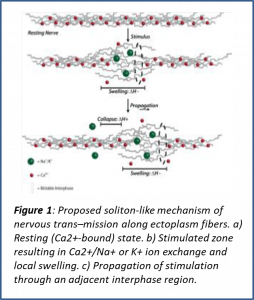Excitable Polyelectrolyte Fiber Networks/Gels
Toward Artificial Neurons
Motivation/Inspiration/Background: Many studies implicate a common underlying mechanism of cellular functions, namely a polymer gel phase transition, in which a major structural change, sometimes associated with electrical signals, is prompted by a subtle environmental change. Specifically, an analogous phase transition in nerve fibers has been proposed. The existence of cation-exchange processes involving Ca2+ and monovalent cations (Na+, K+) in the cortical layer of nerve fibers have been detailed, suggesting that key electrophysiological processes, nerve excitation and conduction, are intimately connected to abrupt phase transitions of the cytoskeleton in the cortical gel layer of the axon. Moreover, it has been suggested that such phenomena can be mimicked using synthetic polyanionic hydrogels, specifically poly(acrylic acid) (PAA) and its salts. We are targeting biomimetic materials with neuron-like excitability and the ability to respond to various stimuli.
Thrust area 3 will use predictions from theory to guide experiments in an attempt to detect signal propagation, as manifested by a propagating ‘interphase’ potential (at the ‘interphase’ between divalent cation- and monovalent cation-rich regions in Figure 1).
Lead PIs: Wnek, Mayer
Faculty Collaborators: de Pablo, Hore, Korley, Griswold, Steinmetz
Graduate Students: Susan Kozawa, Evan Chou, Trevor Kalkus
Undergraduate Students:
High School Envoys: Imari Warfield


